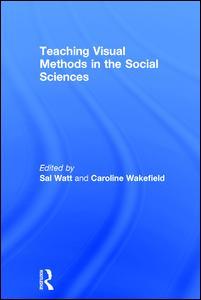Teaching Visual Methods in the Social Sciences
Coordonnateurs : Watt Sal, Wakefield Caroline

Teaching Visual Methods in the Social Sciences presents a practical and theoretical framework for those wanting to introduce visual methods into their curricula. Drawing on the expertise of contributors from across the social sciences, the book provides a comprehensive introduction to visual methodology, learning and teaching theory, and the ethical considerations involved.
Divided into three parts, the book begins with an overview of how visual methods have been used in academic research, and how this can be applied to teaching and pedagogy. It then goes on to introduce different methods, including photography, film and drawing, describing how they can be used in various locations. Finally, the book pulls everything together, advocating the wider use of teaching visual methods in further and higher education curricula across the social science subjects.
The book features a plethora of examples, as well as practical resources for FE and HE teachers, making it an essential companion for anyone interested in utilising visual methods in their teaching.
List of contributors. Preface. Acknowledgements. Part 1: Thinking Through the use of Visual Methods in Learning and Teaching 1. Introduction (Sal Watt and Caroline Wakefield) 2. Looking back: The use of visual methods in the social sciences (Sal Watt and Caroline Wakefield) 3. Research ethics and visual methods (Julie Scott Jones) 4. Visual methods: developing pedagogical application (Caroline Wakefield and Sal Watt) Part 2: Teaching Visual Methods 5. Film: secondary data as a mechanism to support student learning (Moira Lafferty) 6. Drawing: a visual method as an expressive data collection technique (Edd Pitt) 7. Bricolage: Visual and creative arts in the design of applied psychology assessments (Julie Taylor) 8. Students: Examining photo-ethnography and documentary as an unorthodox learning and teaching strategy (Joel Rookwood) 9. Fieldwork: Using visual methods as a tool for field data collection (Janet Speake) 10. Crossing over cultures: Using visual methods in a cross-cultural context for teaching and research (Simon Davies and Lorna Bourke). Part 3: Reflections 11. Practical applications of teaching visual methods (Sal Watt and Caroline Wakefield) 12. Practitioner Resources. Index
Sal Watt is a Senior Lecturer in the Sociology Department at Manchester Metropolitan University. Her expertise is in pedagogical practice and the teaching of research methods. Sal is a Fellow of the HEA and a Chartered Psychologist in learning and teaching.
Caroline Wakefield is an Associate Professor in the Faculty of Science at Liverpool Hope University. Her research and teaching expertise lie in performance enhancement, health and research methods. Caroline is a Fellow of the HEA and is a Chartered Psychologist in learning and teaching.
Date de parution : 05-2017
15.6x23.4 cm
Disponible chez l'éditeur (délai d'approvisionnement : 14 jours).
Prix indicatif 148,11 €
Ajouter au panierDate de parution : 05-2017
15.6x23.4 cm
Disponible chez l'éditeur (délai d'approvisionnement : 14 jours).
Prix indicatif 50,12 €
Ajouter au panierThèmes de Teaching Visual Methods in the Social Sciences :
Mots-clés :
Visual Methods; british; Sri Lankan Students; psychological; Ironman Triathlete; society; Graduate Employability Skills; Caroline Wakefield; Photo Graphs; Julie Scott Jones; Student Engagement; Liverpool Hope University; British Psychological Society Codes; Visual Methods Teaching; Peer Assessment; Vice Versa; Social Science Research; Peer Assessment Forms; Tibetan Students; Critical Visual Methodologies; Visual Research Methods; Photo Elicitation; SOS Child’s Village; Sage Handbook; Field Based Data Collection; Participant Information Sheet; UK Student; Smart City; Mapped Learning Outcomes; UK Volunteer



